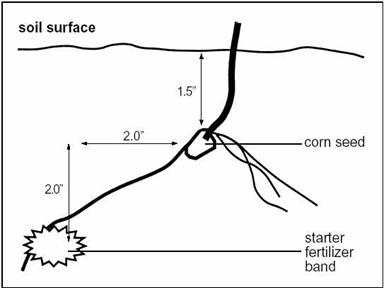Competency Area 4: Nutrient Sources, Analyses, Application Methods
PO 34. Describe advantages and limitations of the following fertilizer placement methods.
- Injection
- Surface broadcast
- Broadcast incorporated
- Band application
- Fertigation
- Foliar application
- Sidedress
- Topdress
- Seed placement
|
Injection is used to place liquid or gaseous fertilizer below the soil near plant roots.
|
UAN application (image source)
|
Surface broadcast is a method by which fertilizer is applied on the surface across an entire field. High capacity fertilizer spreaders are often used which spin dry fertilizer or spray liquid fertilizer on the soil surface or on a growing crop.
|
 |
Broadcast incorporated improves on the efficiency of surface application by incorporating fertilizer through plowing or disking. Plowing is considered better in terms of nutrient availability, as it creates a nutrient-rich zone a few inches below soil surface (where developing plant roots can absorb it).
- Advantages: reduces losses compared to broadcast, improves plant uptake
- Disadvantages: slow, non-uniform application, erosion risk
Band application is also known as starter application. Fertilizer is applied in bands near where developing roots will easily reach it; either to the side and below the seed rows, slightly below the seeds, or in between rows. A common practice is to band fertilizer 2 inches to the side and 2 inches deeper than the seeds or plants. This provides the plants with a concentrated zone of nutrients and can improve nutrient use efficiency. The process can be done before or simultaneous with planting or seed drilling. Liquid or dry fertilizers can be used. |
 |
- Advantages: high nutrient use efficiency, jump-starts early growth. Many fields are deficient in P, due to soil binding and cold temperatures. Banding P makes it easier for plants to grow. It also slows NH4+ conversion to NO3- (nitrification), reducing the risk of leaching.
- Disadvantages: costly, slow; risk of salt burn to plants
Fertigation is distribution with water-soluble fertilizers and chemicals through an irrigation system.
- Advantages: high nutrient use efficiency
- Disadvantages: irrigation equipment needed (injection pump, etc); risk of uneven application in windy situations
Foliar application is application of a small amount of fertilizer or mineral through direct spraying onto the leaves.
- Advantages: rapid uptake
- Disadvantages: phytotoxicity, high expense, limited to small and/or repeated application
Sidedressing is when fertilizer is applied between rows of young plants to provide a boost during periods of rapid growth and nutrient uptake. The most common use is sidedressing N on corn plants. Application amount is dependent on the results of a Pre-Sidedress Nitrate Test (PSNT) done when corn plants are 12-24 inches tall.
- There are three methods of sidedressing:
- UAN applied with a pesticide sprayer fitted with drip nozzles
- UAN injected between corn rows with disc openers
- Anhydrous ammonia injected into soil
- Advantages: high nutrient use efficiency
- Disadvantages: timing often falls during the wet and busy season; slow process
|
Topdressing is when fertilizer or manure is spread on established fields (grasses, legumes).
|
|
|
Seed placement is also known as pop-up application. A small amount of fertilizer is placed with corn seeds during planting, sometimes in conjunction with banding. Both liquid and dry can be used.
|
|
Quick Links
- Competency Area 1: Basic Concepts of Plant Nutrition
- Competency Area 2: Basic Concepts of Soil Fertility
- Competency Area 3: Soil Testing and Plant Tissue Analysis
- Competency Area 4: Nutrient Sources, Analyses, Application Methods
- Competency Area 5: Soil pH and Liming
- Competency Area 6: Nutrient Management and Planning



